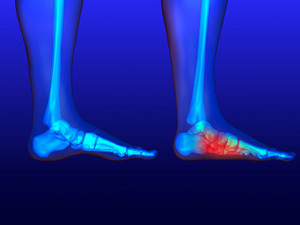Items filtered by date: January 2024
Are Bunions Affecting Your Everyday Life?
Symptoms of Tarsal Tunnel Syndrome

Tarsal tunnel syndrome, a condition affecting the posterior tibial nerve in the ankle, unveils a spectrum of symptoms that can significantly impact one's daily activities. Individuals with this syndrome often experience tingling or burning sensations along the inner ankle and sole of the foot. Numbness may extend to the toes, creating a sense of weakness or instability. Pain, resembling an electric shock or shooting sensation, may radiate from the ankle to the arch of the foot. Swelling in the affected area and a noticeable increase in discomfort during extended periods of standing or walking are common indicators. As the symptoms progress, individuals may find relief through rest but experience a resurgence of discomfort upon resuming activities. Recognizing these various signs is critical for a timely diagnosis and intervention. If you are experiencing one or more of these symptoms, it is suggested that you speak with a podiatrist who can diagnose and treat tarsal tunnel syndrome.
Tarsal tunnel syndrome can be very uncomfortable to live with. If you are experiencing tarsal tunnel syndrome, contact one of our podiatrists of Summit Podiatry. Our doctors can provide the care you need to keep you pain-free and on your feet.
Tarsal Tunnel Syndrome
Tarsal tunnel syndrome, which can also be called tibial nerve dysfunction, is an uncommon condition of misfiring peripheral nerves in the foot. The tibial nerve is the peripheral nerve in the leg responsible for sensation and movement of the foot and calf muscles. In tarsal tunnel syndrome, the tibial nerve is damaged, causing problems with movement and feeling in the foot of the affected leg.
Common Cause of Tarsal Tunnel Syndrome
- Involves pressure or an injury, direct pressure on the tibial nerve for an extended period of time, sometimes caused by other body structures close by or near the knee.
- Diseases that damage nerves, including diabetes, may cause tarsal tunnel syndrome.
- At times, tarsal tunnel syndrome can appear without an obvious cause in some cases.
The Effects of Tarsal Tunnel Syndrome
- Different sensations, an afflicted person may experience pain, tingling, burning or other unusual sensations in the foot of the affected leg.
- The foot muscles, toes and ankle become weaker, and curling your toes or flexing your foot can become difficult.
- If condition worsens, infections and ulcers may develop on the foot that is experiencing the syndrome.
A physical exam of the leg can help identify the presence of tarsal tunnel syndrome. Medical tests, such as a nerve biopsy, are also used to diagnose the condition. Patients may receive physical therapy and prescriptive medication. In extreme cases, some may require surgery.
If you have any questions please feel free to contact one of our offices located in Wilmington, Whiteville, and Wallace, NC . We offer the newest diagnostic and treatment technologies for all your foot and ankle needs.
Symptoms and Diagnostic Insights of Sesamoiditis

Sesamoiditis, a condition affecting the tiny sesamoid bones beneath the big toe, can be challenging to identify but understanding its symptoms is essential for timely intervention. One telltale sign is a gradual onset of pain in the ball of the foot, particularly beneath the big toe. This discomfort may intensify with weight-bearing activities, such as walking or running. Swelling and tenderness around the affected area can also accompany the pain. Accurate diagnosis plays a pivotal role, involving a thorough examination by a podiatrist. This foot doctor may utilize imaging studies such as X-rays to study the sesamoid bones and assess any abnormalities. Additionally, the podiatrist may perform physical tests, evaluating range of motion and pinpointing tender areas. If you have pain in this area of your foot, it is suggested that you consult a podiatrist who can diagnose and treat sesamoiditis.
Sesamoiditis is an unpleasant foot condition characterized by pain in the balls of the feet. If you think you’re struggling with sesamoiditis, contact one of our podiatrists of Summit Podiatry. Our doctors will treat your condition thoroughly and effectively.
Sesamoiditis
Sesamoiditis is a condition of the foot that affects the ball of the foot. It is more common in younger people than it is in older people. It can also occur with people who have begun a new exercise program, since their bodies are adjusting to the new physical regimen. Pain may also be caused by the inflammation of tendons surrounding the bones. It is important to seek treatment in its early stages because if you ignore the pain, this condition can lead to more serious problems such as severe irritation and bone fractures.
Causes of Sesamoiditis
- Sudden increase in activity
- Increase in physically strenuous movement without a proper warm up or build up
- Foot structure: those who have smaller, bonier feet or those with a high arch may be more susceptible
Treatment for sesamoiditis is non-invasive and simple. Doctors may recommend a strict rest period where the patient forgoes most physical activity. This will help give the patient time to heal their feet through limited activity. For serious cases, it is best to speak with your doctor to determine a treatment option that will help your specific needs.
If you have any questions please feel free to contact one of our offices located in Wilmington, Whiteville, and Wallace, NC . We offer the newest diagnostic and treatment technologies for all your foot and ankle needs.
Surgical Options for Big Toe Pain

The metatarsophalangeal, or MTP, a joint that connects the first metatarsal to the big toe's phalanx, is vital for walking. A stiff big toe, medically known as hallux rigidus, can hinder daily activities. If conservative treatments fail, surgery becomes an option. Cheilectomy involves removing bone spurs and bony material from the MTP joint to enhance toe movement. Recovery includes wearing specialized shoes and potentially physical therapy. For severe cases, joint fusion, or arthrodesis, eliminates joint surfaces and fuses bones with wires or plates. Although toe flexibility is lost, joint fusion effectively alleviates most big toe pain, allowing a return to athletic activities post-healing. For moderate to severe hallux rigidus in less active individuals, arthroplasty or joint replacement may be considered. Arthroplasty removes bone and aligns the joint with a pin. Joint replacement substitutes the joint with an artificial one. Long-term outcomes of joint replacement require further research for informed decision-making, comparing it to fusion. For help in understanding these surgical options, it is suggested that you schedule an appointment with a podiatrist who can determine what the best approach is for you. Treatment will be based on severity, pain levels, and activity.
Toe pain can disrupt your daily activities. If you have any concerns, contact one of our podiatrists of Summit Podiatry. Our doctors can provide the care you need to keep you pain-free and on your feet.
What Causes Toe Pain?
Most severe toe pain is caused due to a sports injury, trauma from dropping something heavy on the toe, or bumping into something rigid. Other problems can develop over time for various reasons.
Toe pain can be caused by one or more ailments. The most common include:
- Trauma
- Sports injury
- Wearing shoes that are too tight
- Arthritis
- Gout
- Corns and calluses
- Hammertoe
- Bunions
- Blisters
- Ingrown toenails
- Sprains
- Fractures (broken bones)
- Dislocations
When to See a Podiatrist
- Severe pain
- Persistent pain that lasts more than a week
- Signs of infection
- Continued swelling
- Pain that prevents walking
Diagnosis
In many cases the cause of toe pain is obvious, but in others, a podiatrist may want to use more advanced methods to determine the problem. These can range from simple visual inspections and sensation tests to X-rays and MRI scans. Prior medical history, family medical history, and any recent physical traumatic events will all be taken into consideration for a proper diagnosis.
Treatment
Treatments for toe pain and injuries vary and may include shoe inserts, padding, taping, medicines, injections, and in some cases, surgery. If you believe that you have broken a toe, please see a podiatrist as soon as possible.
If you have any questions please feel free to contact one of our offices located in Wilmington, Whiteville, and Wallace, NC . We offer the newest diagnostic tools and technology to treat your foot and ankle needs.
Ankle Fracture Surgery as a Possible Relief Method

An ankle fracture can be a challenging ordeal, demanding careful consideration and, in some cases, surgical intervention. When a fracture is severe or involves multiple bone fragments, surgery becomes a viable option to restore stability and facilitate proper healing. The surgical procedure typically involves realigning the fractured bones and securing them with metal plates, screws, or rods. The goal is to reconstruct the anatomy of the ankle, allowing for optimal recovery and minimizing the risk of long-term complications. Post-surgery, patients enter a rehabilitation phase that involves a gradual return to weight-bearing activities and physical therapy to restore strength and flexibility. If you are considering ankle surgery, it is suggested that you consult a podiatrist who can determine if this is the correct choice for you.
Foot surgery is sometimes necessary to treat a foot ailment. To learn more, contact one of our podiatrists of Summit Podiatry. Our doctors will assist you with all of your foot and ankle needs.
When Is Surgery Necessary?
Foot and ankle surgery is generally reserved for cases in which less invasive, conservative procedures have failed to alleviate the problem. Some of the cases in which surgery may be necessary include:
- Removing foot deformities like bunions and bone spurs
- Severe arthritis that has caused bone issues
- Cosmetic reconstruction
What Types of Surgery Are There?
The type of surgery you receive will depend on the nature of the problem you have. Some of the possible surgeries include:
- Bunionectomy for painful bunions
- Surgical fusion for realignment of bones
- Neuropathy decompression surgery to treat nerve damage
Benefits of Surgery
Although surgery is usually a last resort, it can provide more complete pain relief compared to non-surgical methods and may allow you to finally resume full activity.
Surgical techniques have also become increasingly sophisticated. Techniques like endoscopic surgery allow for smaller incisions and faster recovery times.
If you have any questions please feel free to contact one of our offices located in Wilmington, Whiteville, and Wallace, NC . We offer the newest diagnostic and treatment technologies for all your foot and ankle needs.
When Flat Feet Need a Surgical Solution

Flat feet, a condition where the arches of the feet are significantly reduced or absent, can cause discomfort and limit mobility for some individuals. While many cases of flat feet can be managed with conservative treatments like orthotics, exercises, and supportive footwear, there are situations where surgery becomes a viable option. Surgical intervention for flat feet typically aims to reconstruct and restore the arches of the feet, improving overall foot function and alleviating pain. This procedure is known as flatfoot reconstruction surgery. Podiatric surgeons may employ various techniques, such as tendon transfers, bone realignment, or the use of implants to achieve the desired results. Candidates for flatfoot surgery often include people who experience severe pain, difficulty in walking, or whose flat feet result from structural abnormalities. If you suspect you may need flatfoot surgery, it is suggested that you schedule an appointment with a podiatrist to discuss whether this is a correct option for you.
Flatfoot is a condition many people suffer from. If you have flat feet, contact one of our podiatrists from Summit Podiatry. Our doctors will treat your foot and ankle needs.
What Are Flat Feet?
Flatfoot is a condition in which the arch of the foot is depressed and the sole of the foot is almost completely in contact with the ground. About 20-30% of the population generally has flat feet because their arches never formed during growth.
Conditions & Problems:
Having flat feet makes it difficult to run or walk because of the stress placed on the ankles.
Alignment – The general alignment of your legs can be disrupted, because the ankles move inward which can cause major discomfort.
Knees – If you have complications with your knees, flat feet can be a contributor to arthritis in that area.
Symptoms
- Pain around the heel or arch area
- Trouble standing on the tip toe
- Swelling around the inside of the ankle
- Flat look to one or both feet
- Having your shoes feel uneven when worn
Treatment
If you are experiencing pain and stress on the foot you may weaken the posterior tibial tendon, which runs around the inside of the ankle.
If you have any questions please feel free to contact one of our offices located in Wilmington, Whiteville, and Wallace, NC . We offer the newest diagnostic and treatment technologies for all your foot and ankle needs.

